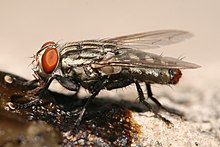Oestroidea
| Oestroidea | |
|---|---|

| |
| Sarcophaga bercaea (Sarcophagidae) | |
| Scientific classification | |
| Domain: | Eukaryota |
| Kingdom: | Animalia |
| Phylum: | Arthropoda |
| Class: | Insecta |
| Order: | Diptera |
| Clade: | Eremoneura |
| (unranked): | Cyclorrhapha |
| Section: | Schizophora |
| Subsection: | Calyptratae |
| Superfamily: | Oestroidea |
| Families | |
|
see text | |
Oestroidea is a superfamily of Calyptratae including the blow flies, bot flies, flesh flies, and their relatives.[1][2] It occurs worldwide and has about 15,000 described species.[3]
The superfamily includes the families:
- Calliphoridae
- Mesembrinellidae (formerly included in Calliphoridae)
- Mystacinobiidae
- Oestridae
- Polleniidae (formerly included in Calliphoridae)
- Rhiniidae (formerly included in Calliphoridae)
- Sarcophagidae
- Tachinidae
- Ulurumyiidae[4]
Ecology
[edit]Oestroidea have a wide range of feeding habits and breeding environments: saprophagous (many Calliphoridae and Sarcophagidae), feeding on blood of birds or mammals (some Calliphoridae), parasites of gastropods or earthworms (some Calliphoridae), parasitoids of arthropods (Rhinophoridae, Tachinidae and some Sarcophagidae), living in association with termites or ants (some Calliphoridae and Rhiniidae), and commensals of bats (Mystacinobiidae).[3][5] Various species of Calliphoridae, Oestridae and Sarcophagidae have larvae that parasitise vertebrates, causing myiasis.[3][5][6]
Phylogeny
[edit]Historically, Oestroidea was considered the sister group to Muscoidea.[1] A 2012 molecular analysis placed the superfamily within a paraphyletic Muscoidea, and also confirmed the monophyly of Oestroidea and of most of its families (except Calliphoridae).[5] Morphological and molecular analyses in 2017 yielded overall similar results.[2] Relationships among the families and subfamilies within Oestroidea are complicated and not well resolved.[2][5]
Evolution
[edit]
The earliest known fossil of Oestroidea is of a Mesembrinellidae found in Dominican amber from the Miocene. The Oestroidea in general are believed to have originated 48.2 million years ago.[2]
Forensic entomology
[edit]Many species of Oestroidea are of forensic importance due to feeding on decomposing animals, including humans.[3]
References
[edit]- ^ a b David K. Yeates, Brian M. Wiegmann (2005). "Phylogeny and evolution of Diptera: recent insights and new perspectives". The Evolutionary Biology of Flies. Columbia University Press. pp. 14–44. ISBN 978-0-231-12700-4.
- ^ a b c d Cerretti, P; Stireman, JO III; Pape, T; O’Hara, JE; Marinho, MAT; Rognes, K; Grimaldi, DA (2017). "First fossil of an oestroid fly (Diptera: Calyptratae: Oestroidea) and the dating of oestroid divergences". PLOS ONE. 12 (8 (e0182101)): e0182101. Bibcode:2017PLoSO..1282101C. doi:10.1371/journal.pone.0182101. PMC 5568141. PMID 28832610.
- ^ a b c d El-Hawagry, M. S.; El-Azab, S. A. (2019). "Catalog of the Calliphoridae, Rhiniidae, and Sarcophagidae of Egypt (Diptera: Oestroidea)". Egyptian Journal of Biological Pest Control. 29 (1): 15. doi:10.1186/s41938-019-0118-8. ISSN 2536-9342.
- ^ Michelsen, Verner; Pape, Thomas (2017). "Ulurumyiidae – a new family of calyptrate flies (Diptera)". Systematic Entomology. 42 (4): 826–836. doi:10.1111/syen.12252. S2CID 90058240.
- ^ a b c d Marinho, M.A.T.; Junqueira, A.C.M.; Paulo, D.F.; Esposito, M.C.; Villet, M.H.; Azeredo-Espin, A.M.L. (2012). "Molecular phylogenetics of Oestroidea (Diptera: Calyptratae) with emphasis on Calliphoridae: Insights into the inter-familial relationships and additional evidence for paraphyly among blowflies". Molecular Phylogenetics and Evolution. 65 (3): 840–854. doi:10.1016/j.ympev.2012.08.007. PMID 22926310.
- ^ Scholl, Philip J.; Colwell, Douglas D.; Cepeda-Palacios, Ramón (2019), "Myiasis (Muscoidea, Oestroidea)", Medical and Veterinary Entomology, Elsevier, pp. 383–419, doi:10.1016/b978-0-12-814043-7.00019-4, ISBN 978-0-12-814043-7, retrieved 2024-10-30
